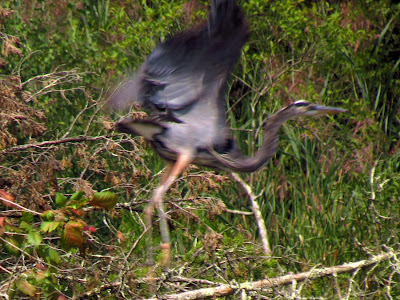Yesterday was supposed to be windy, but that never happened. Instead, it rained for 20 minutes or so every two or three hours and I ended up staying in and working on things. I told S that I would get up early today and go inland to smaller water. While I didn't get up particularly early, at least for me, I did go inland as yesterdays winds arrived this morning and starting out on the ocean would not work.
I started by heading down river because I hadn't gone that way before and I like having a knowledge of the lay of the land. There is much more current below the put-in than above it and the river isn't as wide as I expected. It's a lot of weaving around woody debris - snags, deadheads and downed trees and it might be easier if there was more water. I get the main idea and I turn back short of a mile.
I pass the put-in heading for the Great Swamp as a group of first time kayakers twitch their way into the river. This is a good spot for them - not much trouble to be had and a river that is often less than waist deep.
I spot a great blue heron perched low at the edge of the water about 200 yards off and think about how it is possible to make such a sighting. This time it is geometry - a shape that isn't quite right for where it is, a stump or stub of a drift log that is all the wrong shape. Sometimes, as with a kingfisher, the presence is announced and the sighting of it follows. It reminded me of a time when I was berry picking in the mountains. I stepped out onto an old logging road and froze knowing that something was wrong but I was not able to see it, a disconcerting feeling to be sure. It took several seconds before I made out that about 60 yards away was a bow hunter in a camo gilly suit...who had also froze in position, I suppose to test his gear on me.
 |
| The lightning tree |
I stop briefly and greet the lightning tree. It is a burned tree and the only tree in sight with any burn marks on it and it stands in ground that is permanently saturated. I can only figure it to be a lightning strike.
I meet two kayakers who tell me I can only go another half mile because of a beaver dam, but that isn't true...it's much easier to negotiate a dam with a canoe than with a kayak. And, it means that no one else has gone above that point in the river and an creatures that were there this morning are still there.
The dam was nearly flush on my last trip, but this time there is 2 feet of difference across it. I get out near the bank and make an easy crossing over the top. The lodge that stands just 10 yards away is small but neat and nicely symmetrical with the dam formed in pleasing curves. I notice that the upstream water is as deep, if not deeper, than on my trip here earlier in the summer. The beaver have a good dam.
 |
| First beaver dam with lodge behind on the left |
At the first log crossing, which I remember well because of the gymnastics involved in getting through and past it, it is clear that the water is up a couple inches. Here the river is in the woods and the banks frequently show game trails. I spot a couple beaver scent mounds as well. I take a wrong turn at a fork that I do not remember. The fork peters out after 200 yards, but it pays off as on the return I catch the scent of castoreum (beaver musk), which I haven't smelled since leaving Seattle.
The log crossing section goes easy this time, just two exits from the canoe, the last and worst log jam having been breached at the bank by some nice person. Then, I pass under the road, one of very few roads that cross the swamp, and enter the next open sky swamp. I cross a second beaver dam that at its lowest point is only three or four inches high, and I take a wrong turn into a backwater where I find lodge belonging to the dam. It is large, perhaps 5 feet high, and well hidden from the river due to shrubs growing on that side. I missed completely it last time.
The third dam comes soon after. It is a foot high, but I have gotten what I came for and don't need to cross it. I've seen no one for a couple of miles and could probably sit here for the next week and not see anyone else. I sit and enjoy the wildness.





































